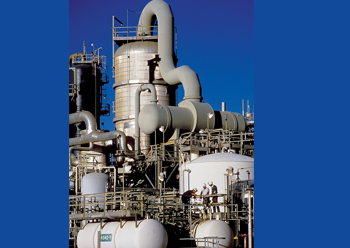
 Sanctions on Russia have opened new possibilities for Middle East exporters
Sanctions on Russia have opened new possibilities for Middle East exporters
The war in Ukraine presents upsides and downsides for Gulf petrochemical companies as European buyers cut purchases of Russian material and look for new import sources while the risk of recession there and economic downturn in China and globally could cut demand for Middle East petrochemicals.
Russia’s invasion of Ukraine has forced buyers in Europe to seek alternatives to Russian molecules, opening up possibilities for Middle East exporters to seize market share. Meanwhile soaring energy and gas costs have sent margins for producers there plummeting, forcing production cuts and even more opportunities for Gulf exporters to help plug the gap.
 |
Elan Habib |
Europe cuts could let Middle East win share Cuts to chemical production in Europe are in sight as elevated feedstock costs have pushed European naphtha cracker margins negative for the first time since ICIS records began, while margins for a host of derivatives have collapsed. These include naphtha-based monoethylene glycol (MEG), polyethylene (PE), acrylonitrile-butadiene-styrene (ABS), styrene, polystyrene (PS), oxo alcohols and propylene oxide (PO). With the fall in crude oil prices, margins have recovered but remain subject to extreme volatility in line with oil.
GCC CHEMICAL MARKETS
Naphtha is closely linked to crude oil and the war in Ukraine has pushed oil prices to levels not seen since the global financial crisis of 2008-2009.
Although values have moderated slightly, Brent is likely to average $110/bbl through the second quarter of 2022, $116.50 in Q3 and $102.50 in Q4, according to the latest ICIS forecast published on 14 March.
European buyers of naphtha – most of whom are avoiding Russian supplies - are being forced to pay a premium for non-Russian product in markets which are already tight. In 2021 Russia supplied 44 per cent of Europe’s naphtha imports which accounted for 20 per cent of regional consumption.
ICIS markets editor, Shruti Salwan, who covers naphtha in Europe said: “My contacts tell me that no one is buying Russian volumes in Europe and amid limited regional availability, buyers have to pay a premium for non-Russian barrels. Lack of Russian naphtha in lows is compounding market woes while relatively reduced refinery throughputs, amid high energy costs and upstream prices, is keeping the market tight.”
European buyers are now looking elsewhere for supplies to fill the void left from Russian material. In recent years Russia has become a major exporter to Europe of polypropylene (PP), high density polyethylene (HDPE), caustic soda and many other products. Upstream it is an important supplier to Europe of gasoil, fuel oil and naphtha.
According to Michael Connolly, ICIS principal analyst for refining: “The Middle East is also a big exporter of naphtha, like Russia, but at the moment most Middle East material goes east to Asia, and hardly any comes to Europe. If Russia finds a home for its naphtha (rejected from Europe) with buyers in Asia, primarily China and India, then we could see some swing of Middle East material to Europe, to maintain global balance.”
Downstream ethylene producers in Europe are likely to cut production rates if running at a loss. “Production cuts will occur if producers can’t run and make money,” according to ICIS analyst James Wilson. “The markets are very volatile at the moment, but our base case is now $100/bbl for the rest of the year so it looks likely this pressure on costs will be sustained.”
DEMAND COLLAPSE RISK
The war in Ukraine has led to soaring energy, power and food prices, sucking money out of consumers’ pockets and shrinking demand and GDP forecasts for mature and emerging economies around the world. These conditions may dampen demand growth prospects for important Middle East export markets such as Europe, the US and China.
Historically, whenever crude prices have doubled in a year, there is a high possibility that economies will go into recession. ICIS can currently see typical precursors to a recession – which is a shock to the system – high inflation, asset bubbles and a loss of consumer confidence.
The war has already caused cuts to GDP forecasts in key markets for Middle East petrochemicals. Oxford Economics has revised down its global GDP forecast from 4.4 per cent to 3.7 per cent year on year in 2022. The group also cut it EU forecast by 1.1 percentage points to 3.3 per cent and China down by half a percentage point to 4.9 per cent.
China’s economy has been sputtering this year as the government tries to reign in its over-heated construction sector amid mushrooming Covid lockdowns in multiple cities. Now the war in Ukraine will add inflationary pressures thanks to rising energy and food prices. On top of that, the war means that demand from China’s key export markets in the US and Europe is less positive. China is also in the midst of a big ramp up in chemical capacities which will see it rely less on imported material.
ICIS senior consultant for Asia, John Richardson, points out that even before the impact of Ukraine, polymer demand was falling in China.
Paul Hodges, chairman of New Normal Consulting said: “It seems virtually certain that Europe is heading into recession, due to the combination of the second Covid wave, high energy prices (particularly gas), continuing supply chain disruption, the rise in inflation, and now the impact of the war in Ukraine – with the key German economy in the eye of the storm.”
Hodges believes disruption to energy markets caused by the Ukraine conflict will accelerate the transition towards a net zero carbon economy.
He said: “In the medium-term, today’s developments will only add to the pressure for localisation and an end to the current dependence on fossil fuels. We are living through a “watershed moment with concerns over energy security, plastic waste and global supply chain chaos adding to the pressures to bring forward Net Zero targets.”
While 2021 brought volatility to chemical markets, Gulf Cooperation Council (GCC) producers were able to maintain high production levels and post strong financial results. But what does 2022 hold for the chemical industry? Oil prices have soared to $130/bbl. for the first time since 2008 amid the Russian-Ukraine conflict, putting petrochemical margins under pressure, with the industry continuing to face high material costs and persistent supply chain concerns.
Russia’s invasion of Ukraine – while first and foremost a humanitarian crisis – has led to more difficult market conditions for 2022, sending commodity markets into turmoil. Consequences of the invasion have sent shockwaves across the global economy, with a geo-political ripple effect in the Middle East, particularly the UAE and Saudi Arabia, who are close allies of the US.
Not only are there consequences in energy and commodity markets, but consequences in food security. The Middle East imports large quantities of wheat from Ukraine, and any disruption in supply could lead to shortages and send food costs skyrocketing. With inflation already a concern globally, additional rising costs would have dire consequences on the Middle Eastern population, lifting the cost of living for many countries in the region.
In this edition of Quarterly View: Inside GCC Chemical Markets, in collaboration with the Gulf Petrochemicals & Chemicals Association (GPCA), we will examine the impact of the conflict on oil, gas, fertilizer, and chemical markets.
As the US plans to ban imports of Russian crude, and a nuclear deal with Iran close to completion, which could send Iranian crude into the market, oil markets could look very different in 2022. With OPEC+ members, UAE and Saudi Arabia, have opposing views on whether or not to boost output to compensate for Russian volumes, several factors could push prices sharply in either direction.
Record high gas prices in Europe, caused by Russia’s invasion of Ukraine and uncertainty over future Russian pipeline gas exports, have raised global spot LNG prices to record highs. In terms of Middle East production, more Qatari LNG may head to European markets in 2022, although this will be tempered by rising long-term contractual commitments from Qatar to Asian LNG buyers, especially in China.
With Russia supplying 20 per cent of the global seaborne ammonia market, fertilizer producers who rely on Russian tonnes are now looking for alternative sources of supply. The European market is hardest hit in terms of availability and price developments stemming from EU sanctions.










